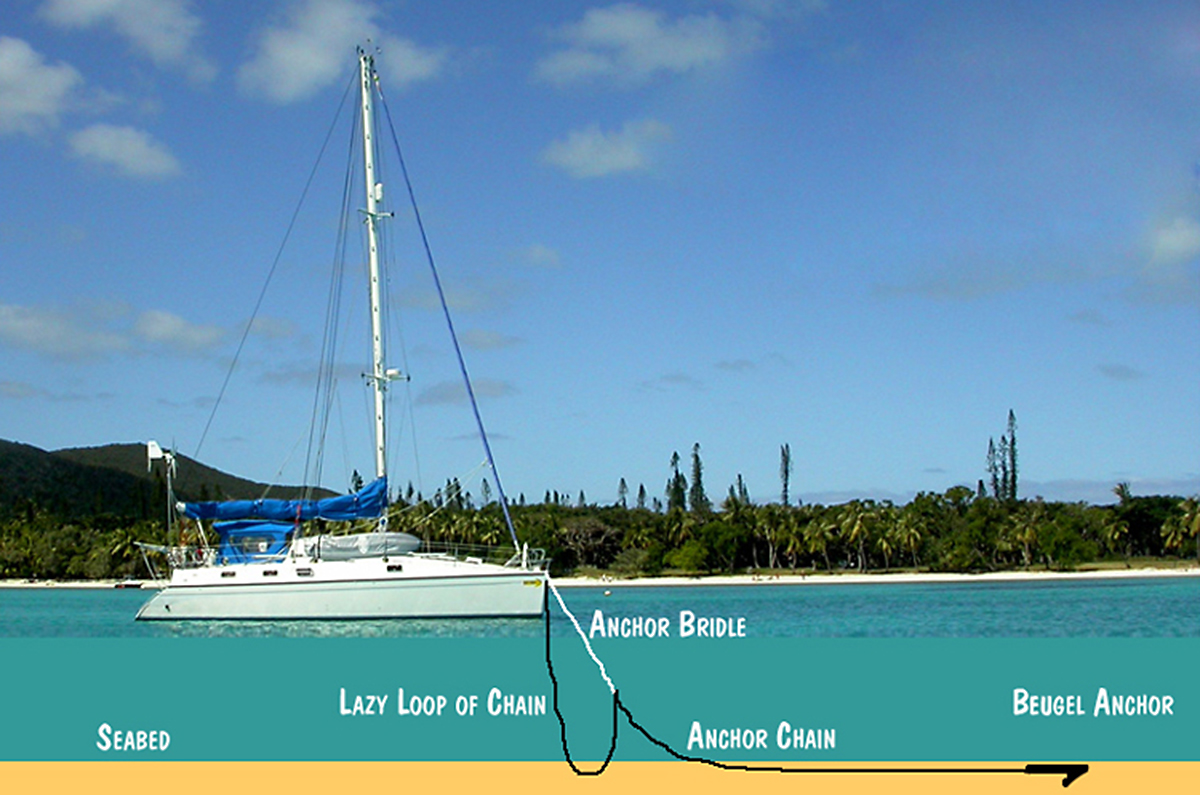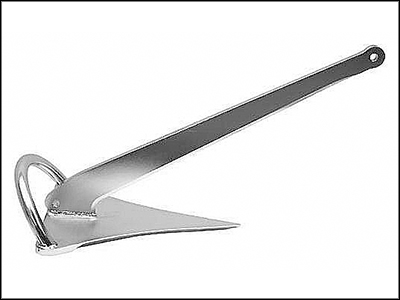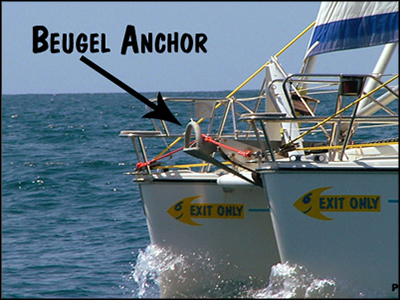

THE ALMOST NEVER FAIL CATAMARAN ANCHORING SYSTEM
Exit Only performed the first half of her circumnavigation navigation using CQR anchors, and the second half using a Beugel anchor.
We started our circumnavigation with a 45 pound CQR, and we dragged it all over the Pacific Ocean.
By the time we reached Tonga, we were tired of dragging anchor, and we moved up to a 60 pound CQR. We thought that the additional weight would keep our CQR from dragging. Unfortunately it didn't work out as hoped.
Even our 60 pound CQR was difficult to set securely in the seabed, and often we would have to make three attempts at anchoring before it held fast. Unfortunately, if there was a wind shift or current shift that reversed the pull on the anchor, we could not trust it to reset in a secure manner.
That made it difficult to leave Exit Only to go ashore with confidence, because we didn't know whether the anchor was going to drag while we were away. We always anchored with 200 feet of 3/8 inch high test chain in addition to the 60 pound CQR.
I had resigned myself to an insecure anchoring fate until I cruised with German yachts in New Caledonia. They had a new anchor called a Beugel.
When we came into an anchorage, they dropped their anchor one time, and it set securely the first time, every time. In the same seabed, we attempted to set our CQR two or three times before it held. This happened time and again.
The German yachts anchored closer to shore in more sheltered conditions because their anchors could be trusted. Their Beugels always held, and if there was a wind shift, their anchors quickly reset, while we were struggling to reset our CQR.buegel-anchor.
When I arrived in Australia, I decided to get a Beugel Anchor to solve my anchoring woes. I was tired of dragging anchors and of long anchor watches.
I purchased a seventy pound Beugel anchor, and it transformed the second half of my trip around the world.
The Beugel anchor stuck to the seabed like it was covered in superglue. It set quickly in the bottom, it didn't drag, and if there was a wind shift, it quickly reset in the new direction.
I finally could sleep soundly through the night because I knew my anchor would hold.
The unique geometry of the Beugel combined with it's sharp narrow tip means that it penetrates and digs into the seabed as soon as it hits the bottom. The semicircular tube on the top of the anchor prevents the anchor from lying upside down on the seabed. If you have an opportunity to play with a Beugel anchor on dry ground, you will instantly understand why it digs in so quickly and securely.
In the second half of the circumnavigation (from Australia to Florida), there were only two occasions when the Beugel had problems.
Once in the Red Sea, we were anchored on a steeply sloping seabed, and we had to anchor in fifty feet of water. The seabed was so steep that it was impossible for the Beugel to dig strongly into the bottom. Although we didn't drag anchor, I could back down on the anchor to seaward and move the anchor. There was no risk of being blown ashore because in that direction the Beugel would have held like a champion. The only risk was being blown offshore by strong winds. It wouldn't have put us in danger, but it would have been inconvenient.
The second time we dragged anchor was in the Canary Islands in a harbor with a rocky bottom. We were anchored in about forty feet of water, and when a sub-tropical storm came through, we dragged anchor. That wasn't a big surprise to us because the bottom was rocky and deep.
Those were the only two occasions where I had to carefully watch for dragging of our Beugel anchor. I reckon that is a good record for the second half of the trip around the world.
The picture at the top of the page shows our customary way of anchoring Exit Only.
First, we set the 70 lb Beugel anchor in the seabed by snubbing it with the engines in reverse. The anchor stops Exit Only dead in its tracks, and we know the anchor is secure.
Second, we use a one inch three strand nylon bridle attached to our two bows. This bridle acts as a shock absorber and keeps Exit Only pointing into the wind and seas.
Third, we use an ABI bridle plate to attach our bridle to the chain.
Fourth, we put a large lazy loop of chain into the water.
The lazy loop of chain weighs thirty to forty pounds, and all that weight causes the bridle to hang nearly straight down from the bow of the boat.
When strong winds and rough seas start to pull hard on the chain, the heavy lazy loop holds the bridle deep under water. It makes the pull of the chain on the anchor more horizontal, and it helps prevent shock loads from being transmitted to the anchor. All of these factors make it less likely that the anchor will jerk out.



Although no anchor is perfect, the Beugel is the closest thing to anchoring perfection that I have experienced. I bet my boat on it many times, and it came through like a champ.
HOW BIG SHOULD YOUR ANCHOR BE?
That depends.
If you worship at the altar of speed, and if you rarely spend the night on the hook, then get a light-weight anchor appropriate to the size and windage of your yacht and to your cruising territory.
If you worship at the altar of security, and if you spend almost every night at anchor, then get a heavier anchor. If you are a world cruiser, then a heavy anchor is the order of the day. After all, you want to be sleeping at night rather than staying up on anchor watch.
Where are you going to be sailing?
If you restrict your movements to an area like the Chesapeake Bay that has fairly shallow anchorages and a muddy bottom, you can safely get a light weight anchor that is specifically designed for mud. The odds are in your favor that you will do fine most of the time.
If you sail from marina to marina, then a smaller and lighter weight anchor will probably work well. What you need is a lunch hook and something that will be secure for the rare occasions that you spend the night anchored out in good weather.
If you sail around the world in your yacht, then you need to have an all around anchor that is big enough to handle the most adverse conditions that you encounter during your voyage. Lightweight anchors might be able to do the job most of the time, but on many occasions you need a heavy anchor that makes it possible to sleep at night and makes it safe to leave your boat when you want to explore ashore. During our circumnavigation, the only places we stayed in marinas was Colon, Balboa, Australia, Bali, Singapore, Langkawi, Turkey, Trinidad, Egypt, and Puerto Rico. Whenever possible during out eleven year voyage, we anchored out. From Turkey to Trinidad, we didn't stay in any marinas.
On Exit Only, we found that a seventy pound Beugel anchor did the job in a reliable manner. One of my friends on a fifty-one foot catamaran is using a one-hundred pound Beugel during his circumnavigation. Seventy pounds of anchor on a 39 foot cat, and one-hundred pounds of anchor on a 51 foot cat worked extremely well for both of us.
Many catamaran sailors worship at the altar of speed, and they don't want the weight of a large anchor on their bow. I agree with them 100%. But I also want to sleep at night, and I want to be able to get off my catamaran and know that Exit Only will still be there when I return from my visit to shore if the wind pipes up, or if there is a shift in tidal current.
How big should your anchor be?
It should be large enough and heavy enough that it will safely hold your vessel in the areas that you sail.
If you are going to sail around the world, it would be wise to get a heavy anchor that will hold your yacht even in stormy conditions.
Awesome music video that captures the essence of what it's like to sail offshore in a catamaran around the world when conditions are less than perfect. David Abbott from Too Many Drummers sings the vocals, and he also edited the footage from our Red Sea adventures. This is the theme song from the Red Sea Chronicles.
Sailing up the Red Sea is not for the faint of heart. From the Bab al Mandeb to the Suez Canal, adventures and adversity are in abundance. If you take things too seriously, you just might get the Red Sea Blues.
If you like drum beats, and you like adventure, then have a listen to the Red Sea Chronicles Trailer.
Flying fish assault Exit Only in the middle of the night as we sail through the Arabian Gulf from the Maldives to Oman. And so begins our Red Sea adventures.
Sailing through Pirate Alley between Yemen and Somalia involves calculated risk. It may not be Russian Roulette, but it is a bit of a worry. Follow Team Maxing Out as they navigate through Pirate Alley.
Stopping in Yemen was just what the doctor ordered. We refueled, repaired our alternator, and we made friends with our gracious Yemeni hosts. We also went to Baskins Robbins as a reward for surviving Pirate Alley.
After you survive Pirate Alley, you must sail through the Gate of Sorrows (Bab Al Mandab) at the southern entrance to the Red Sea. The Gate of Sorrows lived up to its name with fifty knots of wind and a sandstorm that pummeled Exit Only for two days. Life is good.
Join Team Maxingout as they sail through Pirate Alley and up the Red Sea
See what it's like to cruise on a catamaran before you spend a bazillion dollars purchasing one
After watching the Red Sea Chronicles you will be able to see yourself sailing on the ocean of your dreams
Although I like the feel of a paper book in my hand, I love trees even more. When people purchase an eBook, they actually save trees and save money as well. Ebooks are less expensive and have no negative impact on the environment. All of Dr. Dave's books are available at Save A Tree Bookstore. Visit the bookstore today and start putting good things into your mind. It's easy to fill your mind with positive things using eBooks. No matter where you are or what you are doing, you can pull out your smart phone or tablet and start reading. You can even use electronic highlighters and make annotations in your eBooks just like paper books.